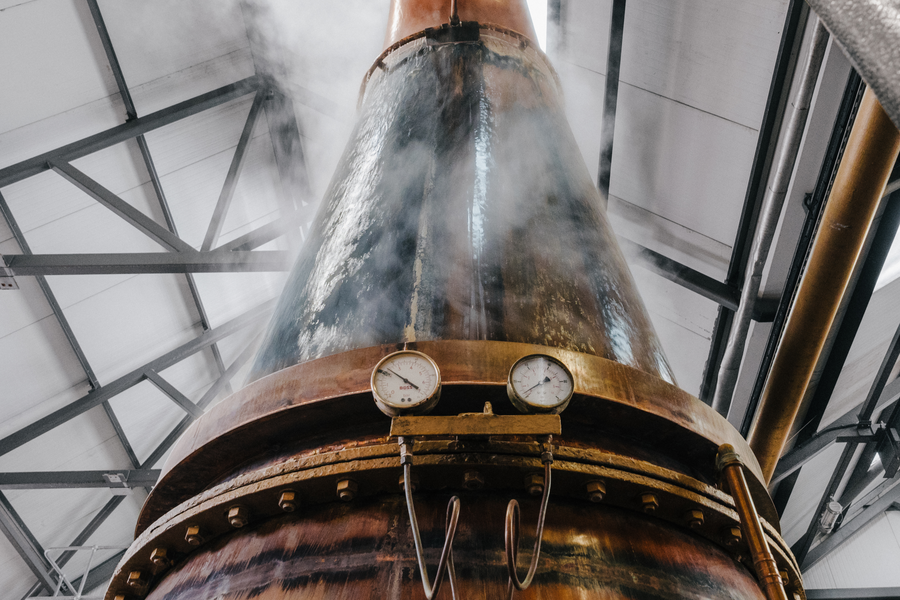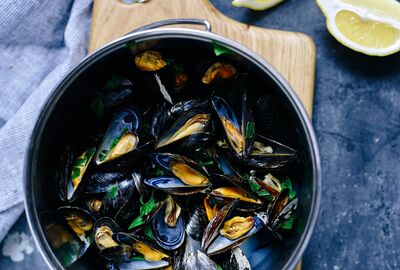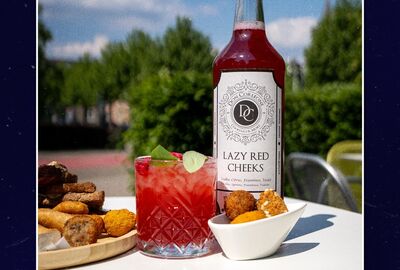
Numerous different types of whisky on shop shelves! But what does it all mean?
There is so much to tell about whisky. We would love to share our passion for whisky with you and are eager to impart our knowledge. Have you always wanted to know the difference between an American bourbon, Irish whiskey and a Japanese Single Malt? We are happy to explain it to you in detail so that you are fully informed. Don't worry, we won't quiz you.
What is whisky?
Whisky is a spirit made from grain, yeast and water. It's as simple as that. Everywhere in the world where grains grow, whisky is distilled.
In 99% of cases, whisky worldwide is allowed to bear that name if it has aged for at least three years in oak barrels. A whisky bottle should always state the country of origin, but that does not automatically mean it is a distinct type of whisky. Often, the country of origin is supplemented by the region. While this is not always mandatory, it does reveal a lot of information.
Start your voyage of discovery through our whiskies >
The 7 main types of whisk(e)y
Blended whisky
By far the most widely drunk and produced type of whisky in the world. By far means around 90-95%. The most well-known variant of blended whisky is blended Scotch whisky.
Blended whisky is a mixture (blend in trade jargon) of matured malt whiskies made from malted barley and matured whisky made from other grains (also called grain whisky). The percentage of grain whisky can vary depending on the brand. In a blend, a carefully composed symphony of different single malt whiskies forms the solid and flavourful base. The grain whisky has a lighter and smoother character, beautifully balancing the intense and complex flavours.
Blended whisky by no means has to be inferior to a single malt, it's just a different kind of whisky. A glass of Robert Burns Blend or Teeling Small Batch is always a pleasure to drink from.
Single malt whisky
The word 'single' causes some confusion for many. A single malt is nothing more and nothing less than a product from a single distillery. So it has nothing to do with a single cask or even casks of the same age.
Single malt whisky is made from malted barley and distilled in the famous copper pot stills, the distinctive copper stills.
There are numerous well-known brands, such as Arran, Jura, Glenglassaugh, Wolfburn or Kilchoman from Scotland, and Kavalan from Taiwan.
Discover numerous single malt whiskies >
Blended malt whisky
Blended malt whisky is a blend of exclusively malt whiskies sourced from different distilleries. The major difference from "ordinary" blended whisky is that blended malts do not use grain whisky.
Although not common, Compass Box's trendy Blended Malt Whiskies might ring a bell. They do not call themselves 'blenders', but 'whiskymakers', and they select the best whiskies from the best distilleries for their unique blends.
Browse through numerous Blended Malt whiskies >
Single grain whisky and blended grain whisky
Grain whisky is made from a grain other than barley, such as wheat and/or maize. It is distilled in fairly large-scale column stills, also known as distillery columns.
As with malt whisky, in this category you also have 'single grain' whisky that comes from just one distillery, and 'blended' whisky that comes from multiple distilleries. Both variants are not very common.
Recommended Grain whiskies include Japan' sNikka Coffey Grain and Ireland's Teeling Single Grain. Although they are an endangered variety, they are definitely worth a look!
An overview of all our grain whiskies >
Rye Whiskey
Rye Whiskey, on the other hand, has rye as its main ingredient, with the legal minimum proportion of rye being 51%. The vast majority of this whiskey comes from Kentucky, United States.
You can compare the use of grains in American whiskey to the taste they have when you bake bread from them. Rye gives a tough, robust and full-bodied flavour.
Maturing in new oak barrels softens the sharpness of the whiskey, but fortunately an edge is always retained. Highly recommended straight from Kentucky is Michter's Rye Whiskey. Another very tasty rye whiskey is Templeton Rye Whiskey.
Discover plenty of rye whiskeys >
Wheat whiskey
Actually, you could stick with the above story and substitute rye for wheat. However, wheat makes a very smooth, easily digestible whiskey that still comes with some body.
Corn whiskey
Corn whiskey is made from at least 80% corn and is mainly made in the United States. It is, especially when aged in oak barrels, buttery smooth and sweet.
Whisky subculture: limited to a country or state
Now we come to the five types that, regardless of all production criteria, may only be made in a particular country or even state.
Bourbon whiskey
Bourbon can be produced anywhere in the United States. It is distilled with at least 51% corn, supplemented by other grains such as rye, wheat and malted barley.
Bourbon can be bottled almost immediately after distillation, but straight bourbon must be matured for at least two years in newly roasted oak barrels. In practice, this actually rarely happens, as a minimum maturation of four years is needed for a deliciously drinkable bourbon.
Kentucky is the birthplace of bourbon and American whiskey in general. Highly recommended? Michter's Bourbon.
Tennessee whiskey
It is stipulated by law that Tennessee whiskey can only be produced in the US state of Tennessee. Moreover, it must follow a mandatory production process in which the distillate, also known as the 'new make' spirit, is filtered, purified and softened immediately after distillation using active charcoal made from maple.
Tennessee whiskey then undergoes a wood maturation similar to that of bourbon.
Take a journey through our Tennessee whiskey >
Canadian whiskey
Canadian whiskey is almost always a blended variety and must of course be produced in Canada. All whiskies are distilled at just one distillery, so in a sense you could call it a single malt.
However, Canadian whisky is generally a blend of two spirits. It is similar to blended whiskies where a more neutral grain whisky is blended with malt whisky.
A neutral whisky is distilled to 95% alcohol and is called the 'base whisky'. This portion has an elegant flavour and can almost be thought of as vodka. The second whisky is called 'flavouring whisky'. This is distilled to a lower alcohol content and is packed with flavour. Both types of whisky mature separately in used and/or new oak barrels.
Canadian whisky is often confused with rye whisky, as rye is the most common grain in the mix of grains for flavouring whisky. Wheat, corn and malted barley are also used.
A few more important facts:
- Canadian whisky can contain a variety of ingredients, from caramel to sherry.
- There are also a few small single malts produced in Canada and, of course, a 'craft-movement' has emerged, characterised by exaggerated facial hair and crafted whisky.
Head for Canada with our Canadian whisky >
Japanese whisky
Japanese whisky is about the pinnacle of whisky these days, but it has been around for less than a century. It began as an approach to peated Scotch whisky by blending imported Scotch whisky with indigenous grain distillates. It has since evolved into an all-Japanese whisky with a character all its own. The best Japanese whiskies have won awards at various whisky rankings around the world for decades. They are becoming increasingly valuable.
Japanese whiskies are distinguished by their refined, clear and balanced character, which is due to small but important differences in the production process. For instance, all distillery whiskies are distilled in-house, with no exchange of casks as in Scotland.
During the fermentation process, not only yeast but also the famous koji mould are added to the grains. This mould is essential for the production of the famous Japanese rice wine 'sake'. Moreover, maturation on Japanese 'Mizunara' oak creates a completely unique and intense aroma.
An iconic and leading brand in the Japanese whisky world is Nikka!
Head towards Asia and discover beautiful Japanese whiskies >
Irish whiskey
Characteristic of Irish whiskey in general is its smooth and light character, often obtained through three rounds of distillation, and the lack of peat to dry the malt. Although there are exceptions to this rule, the smoky and 'peaty' flavours are usually absent.
Besides malt and grain whiskey, Ireland produces another unique variant: 'single pot still whiskey'. This is a blend of unmalted and malted barley, distilled in copper pot stills, and it is produced entirely at one distillery.
For about a decade, the number of Irish whiskey brands and distilleries has exploded with the rise of so-called 'craft spirits'. Besides Teeling , West Cork and The Irishman are two interesting players to keep an eye on.
Wonderful Irish bottlings discover here >
Scotch whisky
First of all: Scotch whisky is not a specific term for a distinct type of whisky! At the same time, Scotch whiskies enjoy the most respect and fame worldwide, and always will. By the way, did you know that Scotland is divided into whisky regions, each with their own characteristics? These regions include the Lowlands, Highlands, Speyside, Campbeltown, the Islands, and finally Islay.
Take your pick from over 1,000 Scotch whiskies >
Peated or not?
When buying a bottle of whisky, one of the seller's first questions will be whether or not you want a peated whisky. By this, the seller means whether you are looking for a peated, smoky whisky or not. When malt is dried with peat during the production process, it gives the drink that unique, smoky character.
Most Scottish blended whiskies contain some peated whiskies in their blend, so they also have a hint or strong peat and smoke flavour.
If you are looking for a fine single malt whisky, you can almost certainly count on a good dose of peat in whiskies from the Isle of Islay, such as Kilchoman. Moreover, peat is part of our unique flavour profile and is grouped into four categories: non-turfed, lightly-turfed, moderately-turfed and heavily-turfed. In addition, our flavour profile consists of: wood, fruit, salty, floral and spicy.
An overview of moderate to firm Peated Whisky >

Marketing • Blogger
As a creative jack-of-all-trades in the marketing world, I also bring that imaginative flair to my drink choices. Whether on a night out, sunny vacation or social gathering with girlfriends, I'm always in my element with a refreshing cocktail in hand. Cocktails have stolen my heart because of the endless possibilities to experiment and explore. My favorite cocktail of the moment is the "Lazy Red Cheeks"! A delicious cocktail using vodka as a base. I love vodka because it mixes perfectly with non-alcoholic drinks. My favorite spirit? Rum!








